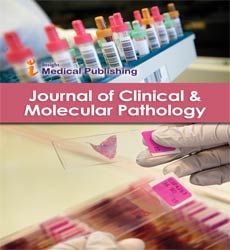ISSN : 2634-7806
Journal of Clinical and Molecular Pathology : Open Access
Cholestasis - Pregnancy .
Fardin Raihan*
Department of Neurology, University of Dhaka, Bangladesh
- *Corresponding Author:
- Fardin Raihan
Department of Neurology, University of Dhaka, Bangladesh
Tel: 002473650014
E-mail:fardin-raihan@gmail.com
Received Date: August 31, 2021; Accepted Date: October 14, 2021; Published Date: October 19, 2021
Citation: Raihan F (2021) Cholestasis – Pregnancy. J Clin Mol Pathol Vol. 5 No: 4
Abstract
With cholestasis, the flow of bile fluid is impaired at some point between the liver cells and the duodenum which is the first segment of the small intestine. When bile flow is stopped, the pigment bilirubin (a waste product formed when old or damaged red blood cells are broken down) escapes into the bloodstream and accumulates. Liver disease in pregnancy encompasses a spectrum of diseases encountered during the gestation and the postpartum period that result in abnormal liver function tests, hepatobiliary dysfunction, or even both. Several disorders contribute to liver disease in pregnancy. These include diseases induced by the pregnancy such as the acute fatty liver of pregnancy (AFLP) and intrahepatic cholestasis of pregnancy (IHCP), diseases that existed before pregnancy that could potentially blaze out during pregnancy such as the autoimmune hepatitis and Wilson’s disease, and diseases that are not related to the pregnancy but that could affect the pregnant woman at any time during the gestation such as viral hepatitis.
Discussion
Cholestasis of pregnancy is a liver problem. It slows down or ceases the normal flow of bile from the gallbladder. This causes itching and yellowing of skin, eyes, and mucous membranes (jaundice). Cholestasis sometimes starts in the early stage of pregnancy. But it is more common in the second and the third trimesters. It most often goes away within a few days after the delivery. The high levels of bile may cause some serious problems for a developing baby (fetus).
The main symptom of cholestasis of pregnancy is severe itching. This is sometimes called pruritus which may be all over the body. But it is more common on the palms of the hands and soles of the feet and may also be worse at night. Other symptoms may include pain in the belly (although this is not common), Light color of stool (bowel movements), Yellow color of skin, eyes, and mucous membranes (jaundice), although this is not common.
The cause of cholestasis of pregnancy is unclear. Your genes may play a role. Sometimes, the condition runs in families. Certain genetic variants have also been identified. Pregnancy hormones also may be involved. Pregnancy hormones may rise the closer the patient get to our due date.
Conclusion
To reduce the risk of the severe problem of cholestasis and the other problems during pregnancy, it is considered important to follow a healthful and a balanced diet along with the plenty of fresh fruit and vegetables. Organic produce is not much likely to be affected by the pesticides and the other toxins. Apples, strawberries, and grapes often contain some higher amounts of unwanted chemicals, while the avocados, sweet corn, and pineapple top the “clean” list. If canned produce is used, check that it is preserved in the own juice and that there are no added sugars. Choose the organic meat and avoid the fried fish and the raw seafood. Dried beans and legumes, such as the lentils and chickpeas, are a good source of the protein. Focus on the whole foods, such as the whole-grain bread.
Open Access Journals
- Aquaculture & Veterinary Science
- Chemistry & Chemical Sciences
- Clinical Sciences
- Engineering
- General Science
- Genetics & Molecular Biology
- Health Care & Nursing
- Immunology & Microbiology
- Materials Science
- Mathematics & Physics
- Medical Sciences
- Neurology & Psychiatry
- Oncology & Cancer Science
- Pharmaceutical Sciences
